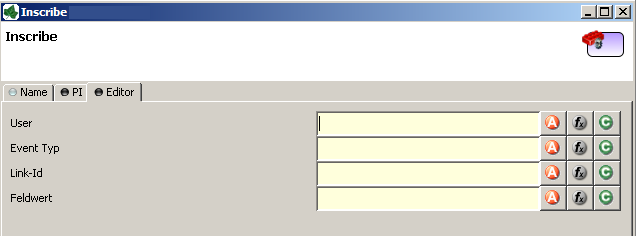Program Start
 The Program Start element is located in the Event & Gateway
drawer of the process editor palette.
The Program Start element is located in the Event & Gateway
drawer of the process editor palette.
Element Details
The program start element allows to start a process by a trigger from
embedded external Java code. This opens a possibility to integrate an
Axon.ivy application into other applications and systems. The program
start element will instantiate a Java class that must implement the
IProcessStartEventBean
interface. The Java class can then start the
process by calling the method fireProcessStartEventRequest on the
Axon.ivy runtime engine
IProcessStartEventBeanRuntime.
The common
way to implement a Start Event Bean is to extend the abstract base class
AbstractProcessStartEventBean.
The interface also includes an inner
editor class to parametrize the bean. You will find the documentation of
the interfaces and abstract class in the Java Doc of the Axon.ivy Public
API.
Note
An Axon.ivy Engine Enterprise Edition consists of multiple engine instances (nodes) that are running on different machines.
Normally process start event beans are instantiated on every node but only started on the master node. This guarantees that for each Program Start process element only one bean is running, no matter what the total number of nodes in the Engine Enterprise Edition is.
However, if you need your process start event bean to be started on all cluster nodes, you may instruct the engine to do so. Just have your bean class implement the (empty) marker interface IMultiNodeCapable and the above restriction will no longer apply.
Please be aware of the fact that having multiple running instances of the same bean may lead to race conditions.
Inscription
Name Tab
The Name Tab is included in the mask of all process elements and contains the name and a description of the element.
Tab Start
On this tab you define the Java class to execute.

Start tab
- Java Class to execute
Full qualified name of the Java class that implements the IProcessStartEventBean interface. Use the New Bean Class Wizard (
 )
to create a new Java
source file with an example implementation of the bean class.
)
to create a new Java
source file with an example implementation of the bean class.- Responsible role
Defines the role that is required to be able to start a process. The bean will set up an authorised session that calls the
fireProcessStartEventRequest()from theeventRuntimeto trigger a process.
Editor Tab
This tab displays the editor that can be integrated in the external Java
bean of the process element. The editor is implemented as an inner
public static class of the Java bean class and must have the name
Editor. Additionally the editor class must implement the
IProcessExtensionConfigurationEditorEx
interface. The common way to
implement the editor class is to extend the abstract base class
AbstractProcessExtensionConfigurationEditor
and to override the
methods createEditorPanelContent, loadUiDataFromConfiguration
and saveUiDataToConfiguration. The method
createEditorPanelContent can be used to build the UI components of
the editor. You can add any AWT/Swing component to the given
editorPanel parameter. With the given editorEnvironment
parameter, which is of the type
IProcessExtensionConfigurationEditorEnvironment,
you can create text
fields that support ivyScript and have smart buttons that provide access
to the process data, environment functions and Java classes.
Here is an example on how an editor could look like:

As you can see, the editor provides access to any process relevant data that can be used by your own process elements. For instance, you can easily transfer process data to your legacy system.
The following part shows the implementation of the above editor. As
mentioned earlier Axon.ivy provides the
IIvyScriptEditor that
represents a text field with ivyScript support and smart buttons. Inside
createEditorPanelContent use the method createIvyScriptEditor
from the editorEnvironment parameter to create an instance of such
an editor. Use the loadUiDataFromConfiguration method to read the
bean configuration and show within the UI components. Inside this method
you can use the methods getBeanConfiguration or
getBeanConfigurationProperty to read the bean configuration. Use the
method saveUiDataToConfiguration to save the data in the UI
components to the bean configuration. Inside this method you can use
methods setBeanConfiguration or setBeanConfigurationProperty to
save the bean configuration.
public static class Editor extends AbstractProcessExtensionConfigurationEditor
{
private IIvyScriptEditor editorUser;
private IIvyScriptEditor editorEventTyp;
private IIvyScriptEditor editorLinkId;
private IIvyScriptEditor editorFieldValue;
@Override
protected void createEditorPanelContent(Container editorPanel,
IProcessExtensionConfigurationEditorEnvironment editorEnvironment)
{
editorPanel.setLayout(new GridLayout(4, 2));
editorUser = editorEnvironment.createIvyScriptEditor(null, null, "String");
editorEventTyp = editorEnvironment.createIvyScriptEditor(null, null, "String");
editorLinkId = editorEnvironment.createIvyScriptEditor(null, null, "String");
editorFieldValue = editorEnvironment.createIvyScriptEditor(null, null);
editorPanel.add(new JLabel("User"));
editorPanel.add(editorUser.getComponent());
editorPanel.add(new JLabel("Event Typ"));
editorPanel.add(editorEventTyp.getComponent());
editorPanel.add(new JLabel("Link-Id"));
editorPanel.add(editorLinkId.getComponent());
editorPanel.add(new JLabel("Feldwert"));
editorPanel.add(editorFieldValue.getComponent());
}
@Override
protected void loadUiDataFromConfiguration()
{
editorUser.setText(getBeanConfigurationProperty("User"));
editorEventTyp.setText(getBeanConfigurationProperty("EventTyp"));
editorLinkId.setText(getBeanConfigurationProperty("LinkId"));
editorFieldValue.setText(getBeanConfigurationProperty("Feldwert"));
}
@Override
protected boolean saveUiDataToConfiguration()
{
setBeanConfigurationProperty("User", editorUser.getText());
setBeanConfigurationProperty("EventTyp", editorEventTyp.getText());
setBeanConfigurationProperty("LinkId", editorLinkId.getText());
setBeanConfigurationProperty("Feldwert", editorFieldValue.getText());
return true;
}
}
At runtime you have to evaluate the IvyScript the user have entered into
the ivy script editors. If you implement for example the
AbstractUserProcessExtension
class there is a perform method which
is executed at runtime. At this point you want to access the configured
data in the editor. The following code snippet show how you can evaluate
the value of an IIvyScriptEditor.
If you use the
IIvyScriptEditor you only get the value by calling the
executeIvyScript method of the AbstractUserProcessExtension.
public CompositeObject perform(IRequestId requestId, CompositeObject in,
IIvyScriptContext context) throws Exception
{
IIvyScriptContext ownContext;
CompositeObject out;
out = in.clone();
ownContext = createOwnContext(context);
String eventtyp = "";
String linkId = "";
String fieldValue = "";
String user= "";
user = (String)executeIvyScript(ownContext, getConfigurationProperty("User"));
eventtyp = (String)executeIvyScript(ownContext, getConfigurationProperty("Event Typ"));
linkId = (String)executeIvyScript(ownContext, getConfigurationProperty("Link-Id"));
fieldValue = (String)executeIvyScript(ownContext, getConfigurationProperty("Feldwert"));
// add your call here
return out;
}